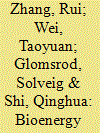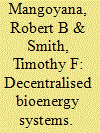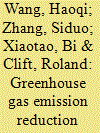|
|
|
Sort Order |
|
|
|
Items / Page
|
|
|
|
|
|
|
| Srl | Item |
| 1 |
ID:
092571


|
|
|
|
|
| Publication |
2009.
|
| Summary/Abstract |
To date, studies of energy siting controversy and of environmental psychology have barely informed one another, despite the environmental-behaviour literature potentially having considerable relevance to understanding public opposition to energy projects. This paper points towards this relevance, using the example of a longitudinal study of public objections to a 21.5 MWe bioenergy gasifier proposed for Winkleigh in Devon, England. Local opinion surveys in 2004 and 2007 showed that public opposition to the proposed gasifier remained strong but also revealed some statistically significant change and correlations of wider interest. In the context of the environmental psychology literature, the dominant model of contextualised values, intention and behaviour, as well as other psychological approaches, are found to be helpful, both for making sense of the results and for informing a psychological research agenda on public objection to new energy infrastructure.
|
|
|
|
|
|
|
|
|
|
|
|
|
|
|
|
| 2 |
ID:
098614


|
|
|
|
|
| Publication |
2010.
|
| Summary/Abstract |
The Energy Independence and Security Act (EISA) of 2007 requires life-cycle assessment (LCA) for quantifying greenhouse gas emissions (GHGs) from expanded U.S. biofuel production. To qualify under the Renewable Fuel Standard, cellulosic ethanol and new corn ethanol must demonstrate 60% and 20% lower emissions than petroleum fuels, respectively. A combined corn-grain and corn-stover ethanol system could potentially satisfy a major portion of renewable fuel production goals. This work examines multiple LCA allocation procedures for a hypothetical system producing ethanol from both corn grain and corn stover. Allocation choice is known to strongly influence GHG emission results for corn-ethanol. Stover-derived ethanol production further complicates allocation practices because additional products result from the same corn production system. This study measures the carbon intensity of ethanol fuels against EISA limits using multiple allocation approaches. Allocation decisions are shown to be paramount. Under varying approaches, carbon intensity for corn ethanol was 36-79% that of gasoline, while carbon intensity for stover-derived ethanol was -10% to 44% that of gasoline. Producing corn-stover ethanol dramatically reduced carbon intensity for corn-grain ethanol, because substantially more ethanol is produced with only minor increases in emissions. Regulatory considerations for applying LCA are discussed.
|
|
|
|
|
|
|
|
|
|
|
|
|
|
|
|
| 3 |
ID:
112933


|
|
|
|
|
| Publication |
2012.
|
| Summary/Abstract |
Increasing international biomass trade for energy and concerns about sustainability of globally traded biomass have raised interest in assessments of cross-border trade related to bioenergy. Within this paper, approaches to overcome methodological difficulties related to biomass trade are proposed and applied for the case of Austria.
Biomass currently has a share of 15.5% in Austria's primary energy consumption of 1354 PJ (2009). According to energy statistics, the rate of self-sufficiency with biomass for energy (defined as the ratio of domestic production to inland consumption, with both imports and exports taken into account) is 91%. However, feedstock imports for transport fuel production and indirect imports of wood-based fuels (wood processing residues and waste liquor of the paper industry originating from imported wood) are not taken into account in energy statistics, but prove to be of some significance. Imports of agricultural commodities to the amount of 9.7 PJ can be attributed to domestic biofuel production, and indirect imports of wood-based fuels, account for 31 PJ. With these import streams taken into account, the share of domestic fuels in bioenergy use is only 67%, rather than 84%, as official energy statistics suggest. On the other hand, Austria is exporting more than 50% of its production of sawnwood, panelboard and paper products.
|
|
|
|
|
|
|
|
|
|
|
|
|
|
|
|
| 4 |
ID:
125403


|
|
|
|
|
| Publication |
2013.
|
| Summary/Abstract |
The EU renewable energy directive stipulates a requirement for 10% of transport fuels to be derived from renewable sources by 2020. Second generation biofuels offer potential to contribute towards this target with cereal straw representing a potentially large feedstock source. From an on-farm survey of 240 arable farmers, timeliness of crop establishment and benefits of nutrient retention from straw incorporation were cited as reasons for straw incorporation. However, two-thirds (one-third) of farmers would supply wheat (barley) straw for bioenergy. The most popular contract length and continuous length of straw supply was either 1 or 3 years. Contracts stipulating a fixed area of straw supply for a fixed price were the most frequently cited preferences, with £50 t-1 the most frequently cited minimum contract price that farmers would find acceptable. Arable farmers in England would be willing to sell 2.52 Mt of cereal straw for bioenergy purposes nationally and 1.65 Mt in the main cereal growing areas of Eastern England. Cereal straw would be diverted from current markets or on-farm uses and from straw currently incorporated into soil. Policy interventions may be required to incentivise farmers to engage in this market, but food and fuel policies must increasingly be integrated to meet societal goals.
|
|
|
|
|
|
|
|
|
|
|
|
|
|
|
|
| 5 |
ID:
136210


|
|
|
|
|
| Summary/Abstract |
Biomass in the form of crop residues and firewood is a major energy source for rural households in China. A survey conducted in the provinces of Shanxi, Zhejiang, and Guizhou shows that 37 percent of rural households use bioenergy for heating and cooking and that bioenergy accounts for 18 percent of their total energy consumption. Most of the biomass used for energy is burned in traditional stoves, contributing to indoor air pollution in rural homes. Crop residues also are commonly burned in the fields, contributing to the high level of outdoor air pollution in China. Our econometric analysis of the key determinants of bioenergy use shows that bioenergy consumption falls modestly with income growth, increased time required for biomass collection, and less farmland. Hence, open burning of some biomass is an optimal choice and is likely to become more of a problem without policy intervention. These findings suggest that a more sustainable use of biomass requires policies that promote cleaner, more efficient bioenergy combustion technologies and increase the economic value of biomass such that local households can benefit from biomass collection.
|
|
|
|
|
|
|
|
|
|
|
|
|
|
|
|
| 6 |
ID:
098690


|
|
|
|
|
| Publication |
2010.
|
| Summary/Abstract |
Finnish farmers' role as energy producers is small compared to their role as energy resource owners. Since climate and energy policy in Finland continues favoring large-scale energy visions, additional investment support for agriculture will stay modest. To utilize fully the energy potential in farms, we analyze the farmers' decision-making environment. First, we present an overview of the Finnish energy policy and economy and their effect on farms (the top-down perspective). Then we analyze the drivers behind the bioenergy decisions of farms in general and in the Oulu region, located in Northern Finland (the bottom-up perspective). There is weak policy coherence between national and regional energy efforts. Strong pressure is placed on farmers to improve their business and marketing knowledge, innovation and financial abilities, education level, and networking skills. In the Oulu region, bioenergy forerunners can be divided in three different groups - investors, entrepreneurs and hobbyists - that have different levels of commitment to their energy businesses. This further stresses the importance of getting quality business services from numerous service providers.
|
|
|
|
|
|
|
|
|
|
|
|
|
|
|
|
| 7 |
ID:
124719


|
|
|
|
|
| Publication |
2013.
|
| Summary/Abstract |
The combination of bioenergy production and carbon capture and storage technologies (BECCS) provides an opportunity to create negative emissions of CO2 in biofuel production. However, high capture costs reduce profitability. This paper investigates carbon price uncertainty and technological uncertainty through a real option approach. We compare the cases of early and delayed CCS deployments. An early technological progress may arise from aggressive R&D and pilot project programs, but the expected cost reduction remains uncertain. We show that this approach results in lower emissions and more rapid investment returns although these returns will not fully materialise until after 2030. In a second set of simulations, we apply an incentive that prioritises sequestered emissions rather than avoided emissions. In other words, this economic instrument does not account for CO2 emissions from the CCS implementation itself, but rewards all the sequestered emissions. In contrast with technological innovations, this subsidy is certain for the investor. The resulting investment level is higher, and the project may become profitable before 2030. Negative emission in bioethanol production does not seem to be a short-term solution in our framework, whatever the carbon price drift.
|
|
|
|
|
|
|
|
|
|
|
|
|
|
|
|
| 8 |
ID:
128365


|
|
|
|
|
| Publication |
2014.
|
| Summary/Abstract |
This paper explores the relationship between bioenergy, rural development and related innovation processes in two case studies (Emilia Romagna in Italy-and Norway), for a better understanding of the impacts of different policy regimes on bioenergy innovation. Regional innovation systems theory is used to explain the results emerging from the case studies and to identify the presence of potential elements for innovation. We used policy and relevant literature analysis and a grounded approach based on semi- structured interviews of relevant actors involved in the local bioenergy system. The main findings show that the case studies present consistent differences in terms of policy instruments and socio-political dynamics. Emilia Romagna has major weaknesses and threats that hinder innovation, but some positive potential elements for the future. Norway presents stronger local elements for innovation within local bioenergy systems, such as the employment of local resources and knowledge, but critical market and policy features that threaten further innovation developments. The conclusion draws on the comparative analysis to discuss policy implications of the study.
|
|
|
|
|
|
|
|
|
|
|
|
|
|
|
|
| 9 |
ID:
168297


|
|
|
|
|
| Summary/Abstract |
Turkey relies heavily on imported fossil fuels to meet a significant portion of its domestic energy demand. This has resulted in a rapid increase in the country's Greenhouse Gas (GHG) emissions over the past decade and raised questions about energy security. To address these challenges, Turkey has established several renewable energy targets, including a target to produce 30 percent of domestic electricity from renewable resources, such as wind, solar and biomass, by 2023. The biomass component is set to reach 1000 MWe by 2023. Given Turkey's large agriculture sector, this paper examines whether agricultural residues can play a role in meeting the biomass component of the renewable electricity target. The analysis is carried out at provincial level, using country-specific data and inputs from national experts and focuses on the crop and livestock bioenergy chains. The assessment results illustrate the bioenergy potential at provincial level, and consequently identify which bioenergy supply chains could be most feasible by province. The paper also quantifies the degree to which the selected bioenergy supply chains can contribute to achieving the biomass component of the renewable electricity target.
|
|
|
|
|
|
|
|
|
|
|
|
|
|
|
|
| 10 |
ID:
113413


|
|
|
|
|
| Publication |
2012.
|
| Summary/Abstract |
Many international policies encourage a switch from fossil fuels to bioenergy based on the premise that its use would not result in carbon accumulation in the atmosphere. Frequently cited bioenergy goals would at least double the present global human use of plant material, the production of which already requires the dedication of roughly 75% of vegetated lands and more than 70% of water withdrawals. However, burning biomass for energy provision increases the amount of carbon in the air just like burning coal, oil or gas if harvesting the biomass decreases the amount of carbon stored in plants and soils, or reduces carbon sequestration. Neglecting this fact results in an accounting error that could be corrected by considering that only the use of 'additional biomass' - biomass from additional plant growth or biomass that would decompose rapidly if not used for bioenergy - can reduce carbon emissions. Failure to correct this accounting flaw will likely have substantial adverse consequences. The article presents recommendations for correcting greenhouse gas accounts related to bioenergy.
|
|
|
|
|
|
|
|
|
|
|
|
|
|
|
|
| 11 |
ID:
103605


|
|
|
|
|
| Publication |
2011.
|
| Summary/Abstract |
The possible uses of biomass for energy provision are manifold. Gaseous, liquid and solid bioenergy carriers can be alternatively converted into heat, power or transport fuel. The contribution of the different utilisation pathways to environmental political targets for greenhouse gas (GHG) emission reduction and energy political targets for the future share of renewable energy vary accordingly to their techno-economic characteristics. The aim of the presented study is to assess the different biomass options against the background of energy and environmental political targets based on a system analytical approach for the future German energy sector. The results show that heat generation and to a lower extent combined heat and power (CHP) production from solid biomass like wood and straw are the most cost effective ways to contribute to the emission reduction targets. The use of energy crops in fermentation biogas plants (maize) and for production of 1st generation transportation fuels, like biodiesel from rapeseed and ethanol from grain or sugar beet, are less favourable. Optimisation potentials lie in a switch to the production of 2nd generation biofuels and the enhanced use of either biomass residues or low production intensive energy crops.
|
|
|
|
|
|
|
|
|
|
|
|
|
|
|
|
| 12 |
ID:
105746


|
|
|
|
|
| Publication |
2011.
|
| Summary/Abstract |
Climate change mitigation and security of energy supply are important targets of Austrian energy policy. Bioenergy production based on resources from agriculture and forestry is an important option for attaining these targets. To increase the share of bioenergy in the energy supply, supporting policy instruments are necessary. The cost-effectiveness of these instruments in attaining policy targets depends on the availability of bioenergy technologies. Advanced technologies such as second-generation biofuels, biomass gasification for power production, and bioenergy with carbon capture and storage (BECCS) will likely change the performance of policy instruments. This article assesses the cost-effectiveness of energy policy instruments, considering new bioenergy technologies for the year 2030, with respect to greenhouse gas emission (GHG) reduction and fossil fuel substitution. Instruments that directly subsidize bioenergy are compared with instruments that aim at reducing GHG emissions. A spatially explicit modeling approach is used to account for biomass supply and energy distribution costs in Austria. Results indicate that a carbon tax performs cost-effectively with respect to both policy targets if BECCS is not available. However, the availability of BECCS creates a trade-off between GHG emission reduction and fossil fuel substitution. Biofuel blending obligations are costly in terms of attaining the policy targets.
|
|
|
|
|
|
|
|
|
|
|
|
|
|
|
|
| 13 |
ID:
103391


|
|
|
|
|
| Publication |
2011.
|
| Summary/Abstract |
Decentralised bioenergy systems are receiving increasing attention due to the potential ability to support local development, create local employment, and contribute to climate change mitigation. These issues, along with other bioenergy sustainability issues, are reviewed through eighteen international case studies with the objective of identifying opportunities and threats to decentralised bioenergy systems. The case studies were selected based on feedstock type, bioenergy type, production capacity, synergistic alliances, ownership structure and physical locations. This variation was used to provide a basis for evaluating opportunities and threats from different contexts. Commercial viability remains the primary concern for the sustainability of decentralised bioenergy systems. There are, however, opportunities for compounding benefits through integrating small scale decentralised bioenergy systems with other production systems. Integrated production, including closed loop models, allow waste materials from one process to be used as inputs in other production processes, and thereby increasing economic, social and environmental outcomes. Synergistic opportunities along the bioenergy production chain, which include feedstock production, bioenergy marketing and distribution could also be exploited by communities and other investors to minimise decentralised production risk.
|
|
|
|
|
|
|
|
|
|
|
|
|
|
|
|
| 14 |
ID:
162960


|
|
|
|
|
| Summary/Abstract |
Taiwan aims to replace all nuclear power with renewable energy by 2025, and thus how much electricity from such sources can actually sustain or improve its energy structure must be thoroughly evaluated. This study is designed to explore the Taiwan's bioenergy potential in the face of climate change and climate-induced crop yield change. Multiple bioenergy technologies and energy crops and residuals are embedded in a two-stage stochastic programming with recourse model to discover their efficiency under changes in crop yields and market conditions. The results show that up to 2.26% of total electricity demand can be fulfilled with pyrolysis-based electricity and more than 3.1 million tons of emission reduction can be achieved. Climate-induced crop yield change, if it is small, shall not have considerable influences on bioenergy technology selection and bioenergy output, but land use may be altered considerably with an additional $NT 2.88 billion dollars in government expenditures on support programs.
|
|
|
|
|
|
|
|
|
|
|
|
|
|
|
|
| 15 |
ID:
127203


|
|
|
|
|
| Publication |
2014.
|
| Summary/Abstract |
The increases in a country's energy capacity are related to its gross domestic product (GDP). In Brazil, increases in income and the consumption of goods and services have led to an increase in the generation of solid waste (SW), which is sent to landfills as a method of treatment and final disposal. The purpose of this study was to facilitate an increase in energy generation from renewable resources, specifically from landfills via thermal biogas plants, and the research was divided into two phases. The first phase involved the assessment of the potential population size contributing to the landfill, which could result in the installation of a financially viable enterprise to generate electricity in Brazil. Next, an estimate of the costs associated with the generation and collection of solid waste in Brazil was predicted by GDP prognoses, the latter being in accordance with the National Energy Balance (Balanço Energético Nacional - BEN) plan created by the Mines and Energy Ministry of Brazil (Ministério de Minas e Energia do Brasil - MME). The net present value (NPV) and internal rate of return (IRR) of each enterprise scenario was used in the first stage to assess the plan's financial viability. In the second stage, estimation curves such as logistics, decreasing rate of growth, and logarithmic curves were used to establish relationships between the generation scenarios and the projected collection of SW and projected GDP. Thus, a range of possible landfill biogas/methane generation values and installed energy capacities were created, considering the extreme maximum and minimum values. These values were related to the energy sources from residual fuels reported by BEN. The results demonstrated that such values still represented a small percentage (0.00020% in 2010 and 0.44496-0.81042% in 2030) of the projected energy generation from residual fuels. Thus, an urgent need was identified to formulate policies that would encourage landfills as a source of renewable energy, broadening the number of financially viable initiatives for energy generation from landfill biogas for populations of fewer than 200,000 inhabitants.
|
|
|
|
|
|
|
|
|
|
|
|
|
|
|
|
| 16 |
ID:
127298


|
|
|
|
|
| Publication |
2014.
|
| Summary/Abstract |
Biodiesel production in Brazil has grown from 736 m3 in 2007 to 2.7 Mm3 in 2012. It is an emergent bioenergy for which it is important to guarantee environmental sustainability. The objective of this article is to characterise the biodiesel production chain in Brazil, to identify potential environmental impacts and to analyse key drivers and barriers for biodiesel environmental sustainability. This article explores these aspects and focusses on the increasing demand for the main feedstocks for biodiesel production in Brazil: soybean oil and beef tallow. The impacts of land use and land-use change on greenhouse gas emissions, biodiversity and water, as well as the energy balance, were found to be critical for the environmental sustainability assessment and development of biodiesel chains. Increasing agriculture yields, diversifying feedstocks and adopting ethyl transesterification can contribute to minimise environmental impacts. It was also found that environmental impacts could be mitigated by appropriate policies aiming at an integrated optimisation of food and bioenergy production and through agro-economic-ecological zoning, allowing adequate use of land for each purpose. Despite the limitation and weakness of some sustainability tools and initiatives, certification and zoning can play an important role in the sustainability of the emerging biodiesel production in Brazil.
|
|
|
|
|
|
|
|
|
|
|
|
|
|
|
|
| 17 |
ID:
124631


|
|
|
|
|
| Publication |
2013.
|
| Summary/Abstract |
This paper argues that an integrated policy architecture consisting of multiple policy phases and economic instruments is needed to support the development of carbon capture and storage (CCS) from its present demonstration phase to full-scale deployment. Building on an analysis of the different types of policy instruments to correct market failures specific to CCS in its various stages of development, we suggest a way to combine these into an integrated policy architecture. This policy architecture adapts to the need of a maturing technology, meets the requirement of policymakers to maintain flexibility to respond to changing circumstances while providing investors with the policy certainty that is needed to encourage private sector investment. This combination of flexibility and predictability is achieved through the use of 'policy gateways' which explicitly define rules and criteria for when and how policy settings will change. Our findings extend to bioenergy-based CCS applications (BECCS), which could potentially achieve negative emissions. We argue that within a framework of correcting the carbon externality, the added environmental benefits of BECCS should be reflected in an extra incentive.
|
|
|
|
|
|
|
|
|
|
|
|
|
|
|
|
| 18 |
ID:
092844


|
|
|
|
|
| Publication |
2009.
|
| Summary/Abstract |
The power system capacity adequacy has public good features that cannot be entirely solved by electricity markets. Regulatory intervention is then necessary and established methods have been used to assess adequacy and help regulators to fix this market failure. In regional electricity markets, transmission interconnections play an important role in contributing to adequacy. However, the adequacy problem and related policy are typically considered at a national level. This paper presents a simple model to study how the interconnection capacity interacts with generation adequacy. First results indicate that increasing interconnection capacity between systems improves adequacy up to a certain level; further increases do not procure additional adequacy improvements. Furthermore, besides adequacy improvement, increasing transmission capacity under asymmetric adequacy criteria or national system characteristics could create several concerns about externalities. These results imply that regional coordination of national adequacy policies is essential to internalise adequacy of cross-border effects.
|
|
|
|
|
|
|
|
|
|
|
|
|
|
|
|
| 19 |
ID:
104893


|
|
|
|
|
| Publication |
2011.
|
| Summary/Abstract |
The contribution of biofuels to the saving of greenhouse gas (GHG) emissions has recently been questioned because of emissions resulting from land use change (LUC) for bioenergy feedstock production. We investigate how the inclusion of the carbon effect of LUC into the carbon accounting framework, as scheduled by the European Commission, impacts on land use choices for an expanding biofuel feedstock production. We first illustrate the change in the carbon balances of various biofuels, using methodology and data from the IPCC Guidelines for National Greenhouse Gas Inventories. It becomes apparent that the conversion of natural land, apart from grassy savannahs, impedes meeting the EU's 35% minimum emissions reduction target for biofuels. We show that the current accounting method mainly promotes biofuel feedstock production on former cropland, thus increasing the competition between food and fuel production on the currently available cropland area. We further discuss whether it is profitable to use degraded land for commercial bioenergy production as requested by the European Commission to avoid undesirable LUC and conclude that the current regulation provides little incentive to use such land. The exclusive consideration of LUC for bioenergy production minimizes direct LUC at the expense of increasing indirect LUC.
|
|
|
|
|
|
|
|
|
|
|
|
|
|
|
|
| 20 |
ID:
171513


|
|
|
|
|
| Summary/Abstract |
The Canadian province of British Columbia (BC) provides an informative case study of bioenergy development, because it relies heavily on fossil fuels but has enormous bioenergy potential. We have examined the potential contribution of bioenergy to reducing BC's GHG emissions. The approach of combining life cycle assessment and economic evaluation to prioritize options should be applicable generally. Biomass availability, including forestry resources, agricultural waste and municipal solid waste, is estimated. Through simplified Life Cycle Assessment, GHG reduction potential of biogas, bioethanol, biofuels from hydrothermal liquefaction, and district heating are quantified, along with the associated GHG reduction costs. The analysis shows that existing biomass resources could yield 110–176 PJ per year, reducing GHG emissions by 13.0–15.7%. Bioenergy from waste streams is already cost-effective and should be prioritized in the short term. However, bioenergy from forestry resources, especially conversion to liquid biofuels, is prohibitively expensive, with GHG reduction cost exceeding CAD $300/t CO2-eq. The total extra cost required to achieve full utilization of BC's biomass resources is estimated as 0.8–2.4 billion dollars. To close the cost gaps between bioenergy and fossil fuels, both technological improvement and external cost adjustment through measures like carbon taxation will be needed.
|
|
|
|
|
|
|
|
|
|
|
|
|
|
|
|
|
|
|
|
|